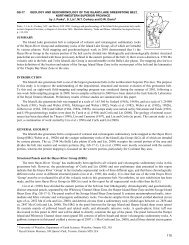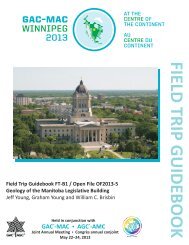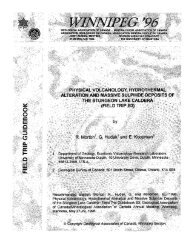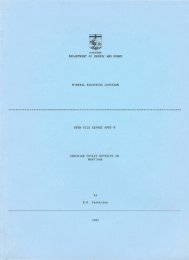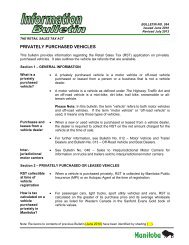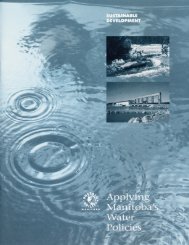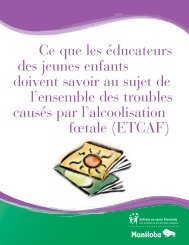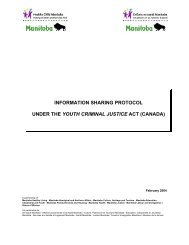Nutrient Management Strategy - Government of Manitoba
Nutrient Management Strategy - Government of Manitoba
Nutrient Management Strategy - Government of Manitoba
Create successful ePaper yourself
Turn your PDF publications into a flip-book with our unique Google optimized e-Paper software.
Page 5Item 3: Managing <strong>Nutrient</strong> SourcesSome jurisdictions have already developed, orare in the process <strong>of</strong> developing a watershed (ordrainage basin) based approach to nutrientmanagement. The watershed approach involvesfirst identifying all <strong>of</strong> the inputs to the riversystem within a basin or watershed, followed bythe development and implementation <strong>of</strong> strategiesaimed at reducing these inputs. The watershed orbasin management approach is <strong>of</strong>ten multidisciplinaryand requires the cooperation <strong>of</strong> allstakeholders within the watershed. The approachis in keeping with the overall movement towards amore holistic, ecosystem-based approach toenvironmental management.<strong>Nutrient</strong> sources that are discrete observabledischarges are called point sources, while sourcesthat are more diffuse and more difficult to quantifyare called non-point sources.Control <strong>of</strong> <strong>Nutrient</strong> Loading from PointSourcesPoint sources <strong>of</strong> nutrients in southern<strong>Manitoba</strong> include wastewater treatment lagoondischarges, sewage and wastewater treatment plantdischarges, urban storm water drains, andchannelled run-<strong>of</strong>f associated with large livestockoperations. Issues and actions to consider in thecontrol <strong>of</strong> nutrient inputs from point sourcesinclude:A. All point sources <strong>of</strong> nutrients have to beidentified and any information/data aboutnutrient loading from these point sources hasto be gathered. This information can then beanalyzed/modelled along with existing streamnutrient and flow data to ensure compliancewith the nutrient objectives <strong>of</strong> the stream.B. In cases where non-compliance occurs,nutrient control measures such as tertiarytreatment (e.g. constructed wetlands) ornutrient reduction technology (e.g. alumapplications) may have to be considered.C. In the case <strong>of</strong> streams that have multiple pointsources, the sources will be encouraged tocoordinate their discharges in such a way as toensure that stream nutrient objectives are notexceeded and water use is not compromisedduring discharge periods.D. Point source discharges may have to berelocated to minimize negative impacts to thewaterway and to water uses along thewaterway.E. Education awareness campaigns may need tobe initiated that are aimed at reducing nutrientinputs in domestic and industrial wastewater.Control <strong>of</strong> <strong>Nutrient</strong> Loading from Non-pointSourcesNon-point source loading refers to nutrientloading from land surface run-<strong>of</strong>f across awatershed or catchment basin. Non-point sources<strong>of</strong> nutrients in southern <strong>Manitoba</strong> include surfacewater run<strong>of</strong>f from urban areas, fertilized fields,pastures, and livestock holding areas. Run-<strong>of</strong>ffrom non-fertilized lands can also be considered anon-point source <strong>of</strong> nutrients simply because <strong>of</strong>the naturally high soil fertility in some parts <strong>of</strong>southern <strong>Manitoba</strong>. Other non-point sources <strong>of</strong>nutrients include atmospheric deposition andgroundwater seepage.In general, nutrient inputs to a waterway fromnon-point sources tend to be extremely variable,intermittent, and difficult to predict and control.This makes assessing their contribution to theeutrophication <strong>of</strong> a given waterway much moredifficult to ascertain. Some management practicesthat help to control non-point source loading <strong>of</strong>nutrients to waterways include:A. Control <strong>of</strong> run<strong>of</strong>f waters and soil erosion fromagricultural and urban areas through improvedmethods <strong>of</strong> landscaping.B. Use <strong>of</strong> precision farming practices to limit theamount <strong>of</strong> excess chemical fertilizers andmanure applied to cultivated land.C. Preservation or re-establishment <strong>of</strong> riparianvegetation along waterways.D. Restricted access <strong>of</strong> cattle and other livestockto waterways.For Additional Information, Visit <strong>Manitoba</strong> Conservation’s Website for Current Issues - Latest Newswww.gov.mb.ca/environ/



